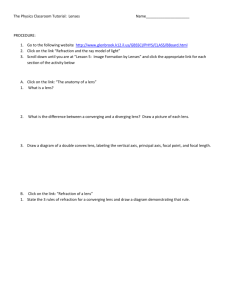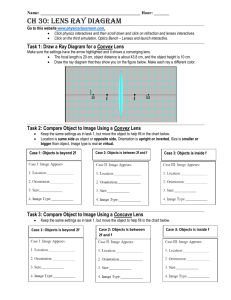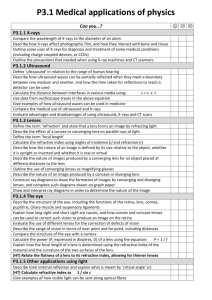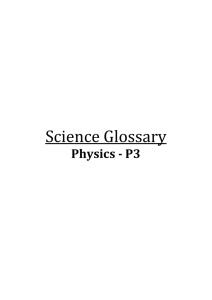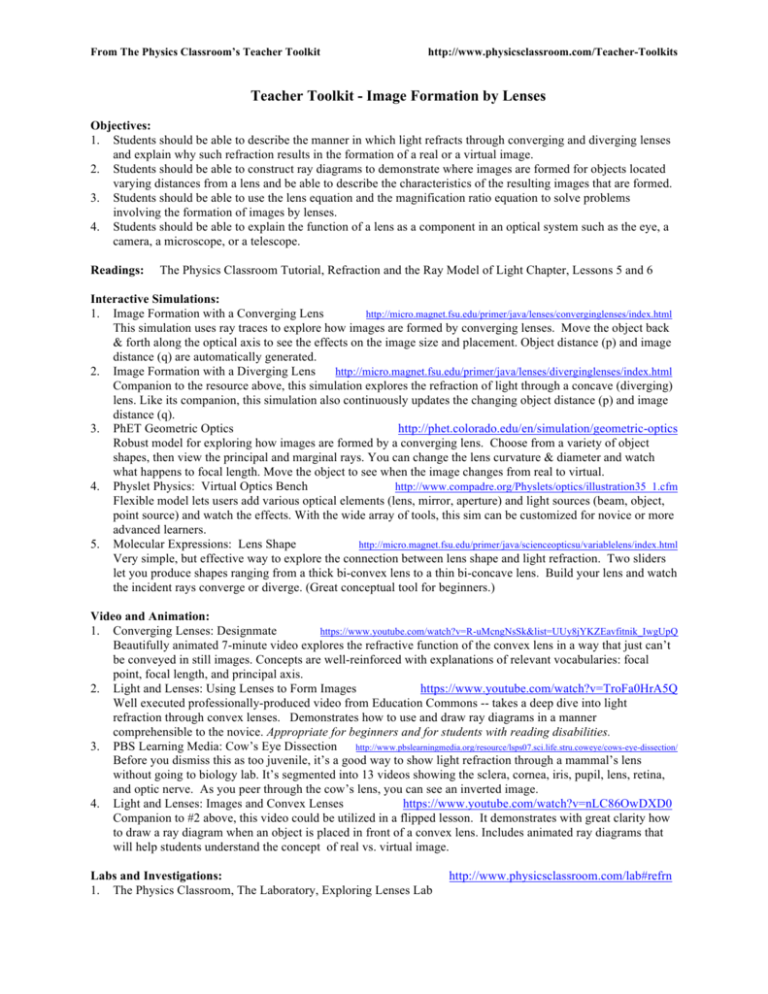
From The Physics Classroom’s Teacher Toolkit
http://www.physicsclassroom.com/Teacher-Toolkits
Teacher Toolkit - Image Formation by Lenses
Objectives:
1. Students should be able to describe the manner in which light refracts through converging and diverging lenses
and explain why such refraction results in the formation of a real or a virtual image.
2. Students should be able to construct ray diagrams to demonstrate where images are formed for objects located
varying distances from a lens and be able to describe the characteristics of the resulting images that are formed.
3. Students should be able to use the lens equation and the magnification ratio equation to solve problems
involving the formation of images by lenses.
4. Students should be able to explain the function of a lens as a component in an optical system such as the eye, a
camera, a microscope, or a telescope.
Readings:
The Physics Classroom Tutorial, Refraction and the Ray Model of Light Chapter, Lessons 5 and 6
Interactive Simulations:
1. Image Formation with a Converging Lens
http://micro.magnet.fsu.edu/primer/java/lenses/converginglenses/index.html
This simulation uses ray traces to explore how images are formed by converging lenses. Move the object back
& forth along the optical axis to see the effects on the image size and placement. Object distance (p) and image
distance (q) are automatically generated.
2. Image Formation with a Diverging Lens
http://micro.magnet.fsu.edu/primer/java/lenses/diverginglenses/index.html
Companion to the resource above, this simulation explores the refraction of light through a concave (diverging)
lens. Like its companion, this simulation also continuously updates the changing object distance (p) and image
distance (q).
3. PhET Geometric Optics
http://phet.colorado.edu/en/simulation/geometric-optics
Robust model for exploring how images are formed by a converging lens. Choose from a variety of object
shapes, then view the principal and marginal rays. You can change the lens curvature & diameter and watch
what happens to focal length. Move the object to see when the image changes from real to virtual.
4. Physlet Physics: Virtual Optics Bench
http://www.compadre.org/Physlets/optics/illustration35_1.cfm
Flexible model lets users add various optical elements (lens, mirror, aperture) and light sources (beam, object,
point source) and watch the effects. With the wide array of tools, this sim can be customized for novice or more
advanced learners.
5. Molecular Expressions: Lens Shape
http://micro.magnet.fsu.edu/primer/java/scienceopticsu/variablelens/index.html
Very simple, but effective way to explore the connection between lens shape and light refraction. Two sliders
let you produce shapes ranging from a thick bi-convex lens to a thin bi-concave lens. Build your lens and watch
the incident rays converge or diverge. (Great conceptual tool for beginners.)
Video and Animation:
1. Converging Lenses: Designmate
https://www.youtube.com/watch?v=R-uMcngNsSk&list=UUy8jYKZEavfitnik_IwgUpQ
Beautifully animated 7-minute video explores the refractive function of the convex lens in a way that just can’t
be conveyed in still images. Concepts are well-reinforced with explanations of relevant vocabularies: focal
point, focal length, and principal axis.
2. Light and Lenses: Using Lenses to Form Images
https://www.youtube.com/watch?v=TroFa0HrA5Q
Well executed professionally-produced video from Education Commons -- takes a deep dive into light
refraction through convex lenses. Demonstrates how to use and draw ray diagrams in a manner
comprehensible to the novice. Appropriate for beginners and for students with reading disabilities.
3. PBS Learning Media: Cow’s Eye Dissection
http://www.pbslearningmedia.org/resource/lsps07.sci.life.stru.coweye/cows-eye-dissection/
Before you dismiss this as too juvenile, it’s a good way to show light refraction through a mammal’s lens
without going to biology lab. It’s segmented into 13 videos showing the sclera, cornea, iris, pupil, lens, retina,
and optic nerve. As you peer through the cow’s lens, you can see an inverted image.
4. Light and Lenses: Images and Convex Lenses
https://www.youtube.com/watch?v=nLC86OwDXD0
Companion to #2 above, this video could be utilized in a flipped lesson. It demonstrates with great clarity how
to draw a ray diagram when an object is placed in front of a convex lens. Includes animated ray diagrams that
will help students understand the concept of real vs. virtual image.
Labs and Investigations: 1. The Physics Classroom, The Laboratory, Exploring Lenses Lab
http://www.physicsclassroom.com/lab#refrn
This is the To Go version of the Teacher Toolkit; it is an abbreviated version of the complete Toolkit.
2.
3.
Students look through converging and diverging lenses at the image of nearby and distant objects and describe
their orientation and relative size.
The Physics Classroom, The Laboratory, L•O•S•T Art of Image Description
Students place a converging lens on an optics bench and investigate how the object location affects the
characteristics of the image that is formed.
The Physics Classroom, The Laboratory, Lens Equation Lab
Students collect data for the dependence of the image distance upon the object distance for a converging lens.
By plotting and analyzing the data, an equation relating these two quantities is derived.
Demonstration Ideas: (Full descriptions and links in the Complete Toolkit at TPC’s Teacher Toolkit website)
1. PBS Learning Media: Refraction of Light Demo
2. Snell’s Law of Refraction
3. PBS Learning Media: Observing Refraction of Light
Minds On Physics Internet Modules:
http://www.physicsclassroom.com/mop
The Minds On Physics Internet Modules are a collection of interactive questioning modules that target conceptual
understanding. Each question is accompanied by detailed help addressing the various components of the question.
1. Refraction and Lenses, Assignment RL7 - Converging vs. Diverging Lenses
2. Refraction and Lenses, Assignment RL8 – Converging Lenses – Ray Tracing
3. Refraction and Lenses, Assignment RL9 – Converging Lenses – Image Characteristics
4. Refraction and Lenses, Assignment RL10 – Diverging Lenses – Ray Tracing
5. Refraction and Lenses, Assignment RL11 – Diverging Lenses – Image Characteristics
Conceptual Building Exercises: The Curriculum Corner, Refraction and Lenses,
1. Lenses
2. Ray Diagrams for Converging Lenses
http://www.physicsclassroom.com/curriculum/refrn
3. Ray Diagrams for Diverging Lenses
Problem-Solving Exercises:
1. The Calculator Pad, Refraction and Lenses, Problems #19-32
Science Reasoning Activities:
1. Science Reasoning Center, Lens Magnification
2. ACT Test Center, Depth of Field
http://www.physicsclassroom.com/calcpad/refrn
http://www.physicsclassroom.com/reasoning/refraction
http://www.physicsclassroom.com/actprep
Real Life Connections
(See the complete toolkit at TPC’s Teacher Toolkit website for links and details.)
1. Corning, Inc: Fiber 101
2. Fiber Optic Association: Where are the Jobs in Fiber Optics?
Common Misconceptions
(See the complete toolkit at TPC’s Teacher Toolkit website.)
Elsewhere on the Web
(See the complete toolkit at TPC’s Teacher Toolkit website.)
Standards:
A. Next Generation Science Standards (NGSS) – Grades 9-12
Performance Expectations - Waves and Their Applications in … : HS-PS4-1
Disciplinary Core Ideas - Electromagnetic Radiation: MS-PS4.B.i and MS-PS4.B.ii
Crosscutting Concepts: Patterns and Systems and System Models
Science and Engineering Practices: #1, #4, #5, #6, and #8
B. Common Core Standards for Mathematics (CC) – Grades 9-12
(See the complete toolkit at TPC’s Teacher Toolkit website for details.)
C. Common Core Standards for English/Language Arts (ELA) – Grades 9-12
Key Ideas and Details
RST.11-12.2 and RST.11-12.3
Craft and Structure RST.11-12.4
Integration of Knowledge and Ideas RST.11-12.9
Range of Reading and Level of Text Complexity RST.11-12.10
D. College Ready Physics Standards (Heller and Stewart)
(See the complete toolkit at TPC’s Teacher Toolkit website for details.)
©The Physics Classroom, All Rights Reserved
This document should NOT appear on other websites.


